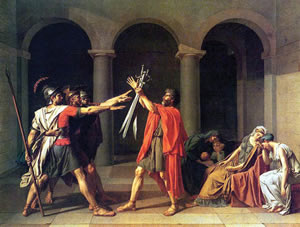 Caption: Oath of the Horatii (after David), Joe Forkan, 2010; The Lebowski Cycle paintings are on exhibit at Orange Coast College in Costa Mesa through Oct. 28.
Caption: Oath of the Horatii (after David), Joe Forkan, 2010; The Lebowski Cycle paintings are on exhibit at Orange Coast College in Costa Mesa through Oct. 28.
The Dude Abides as Art
Mashup of art history, film and narrative
Artist Talk This Thursday at 7 p.m.
What: "Ideas and Process: Painting The Lebowski Cycle" is the artist's gallery talk on the creative process behind the series of 14 paintings and drawings now on exhibit at Orange Coast College. The illustrated lecture will explore the paintings that inspired the project, and the process of exploring layered narratives, using masterpieces of European art and the 1998 Coen Brothers' flm The Big Lebowski as a startng point.
Who: Joe Forkan, associate professor of art and member of the CSUF Visual Arts faculty since 2002.
Where: The exhibition is on display through October 28 at the Frank M. Doyle Arts Pavillion at Orange Coast College, at 2701 Fairview Road, Costa Mesa, CA 92626.
When: The gallery talk will take place this Thursday, Sept. 29, from 7- 9 p.m.
Additional: The Doyle Arts Pavilion at Orange Coast College is open Tuesday, Thursday and Friday 11 a.m. – 5 p.m. and Wednesday 11 a.m. – 8 p.m. It is closed Saturday, Sunday and Monday. For infomation and directions, e-mail: alharris@occ.cccd.edu. Additional information can be found at the artist's website and blog.
Cost: This exhibit is free to the public. Parking is available in lot D9 off Merrimac.
 Caption: Source image (above) Oath of the Horatii, Jacques-Louis David, 1784
Caption: Source image (above) Oath of the Horatii, Jacques-Louis David, 1784
Why: According to the artist's posted statement in the gallery, "The series is the result of a longstanding interest in narrative painting, particularly paintings from the Baroque and Neoclassical eras; complex figurative works that depict grand story arcs, compressing a multitude of thoughts, ideas and emotions into a singular image. However, it is the human interactions and conflicts, formal qualities, and modes of depiction that were as interesting to me as the specific stories.
"I wanted to explore these ideas, but looked for a way to mitigate the grand seriousness that historical and religious paintings often contain. I started thinking about The Big Lebowski, (a favorite film, obviously) trying to imagine how the characters, humor and preposterous story arc of the film might be enlisted to explore multiple points of view, moods, and intentions if combined with themes and titles from well-known works of European art.
Jacques-Louis David's Oath of the Horatii, pictured above right, provided the source image for the central piece in the exhibit, Oath of the Horatii (after David), the image at the top of this page. It was the 18th century painting that prompted his initial exploration into narrative paintings, he explains.
"David's Oath of the Horatii was really the one that triggered the idea. I was thinking about the grand seriousness of this kind of painting, looking for a way to build a more open narrative – one that would not get stuck in a single reading, or be too grim, as this type of painting often is.
"I started looking at The Big Lebowski as a possible source, trying to imagine how the great characters, playful humor, and preposterous story arc of the film might be enlisted to build some more layered narratives; paintings with multiple points of view, moods, and intentions.
"However, the Coen brothers were already really working with layered genres and different archetypes in the film. They constructed a labyrinthine narrative in the manner of a Raymond Chandler novel, and replaced the hardboiled detective with an aging pothead. This gave them great storytelling possibilities, playing off of and to the conventions of different genres. At one point, this leads to a Film Noir dream sequence filmed as a Busby Berkeley musical in a bowling alley with a character costumed from a Wagner Opera. If you get all the references, it's great, if not - it's still rich storytelling. So, I wanted to use disparate sources and conventions to make hybrid images that reference art history, film, and contemporary art, creating a lot of ways to enter the work."
09/28/2011
